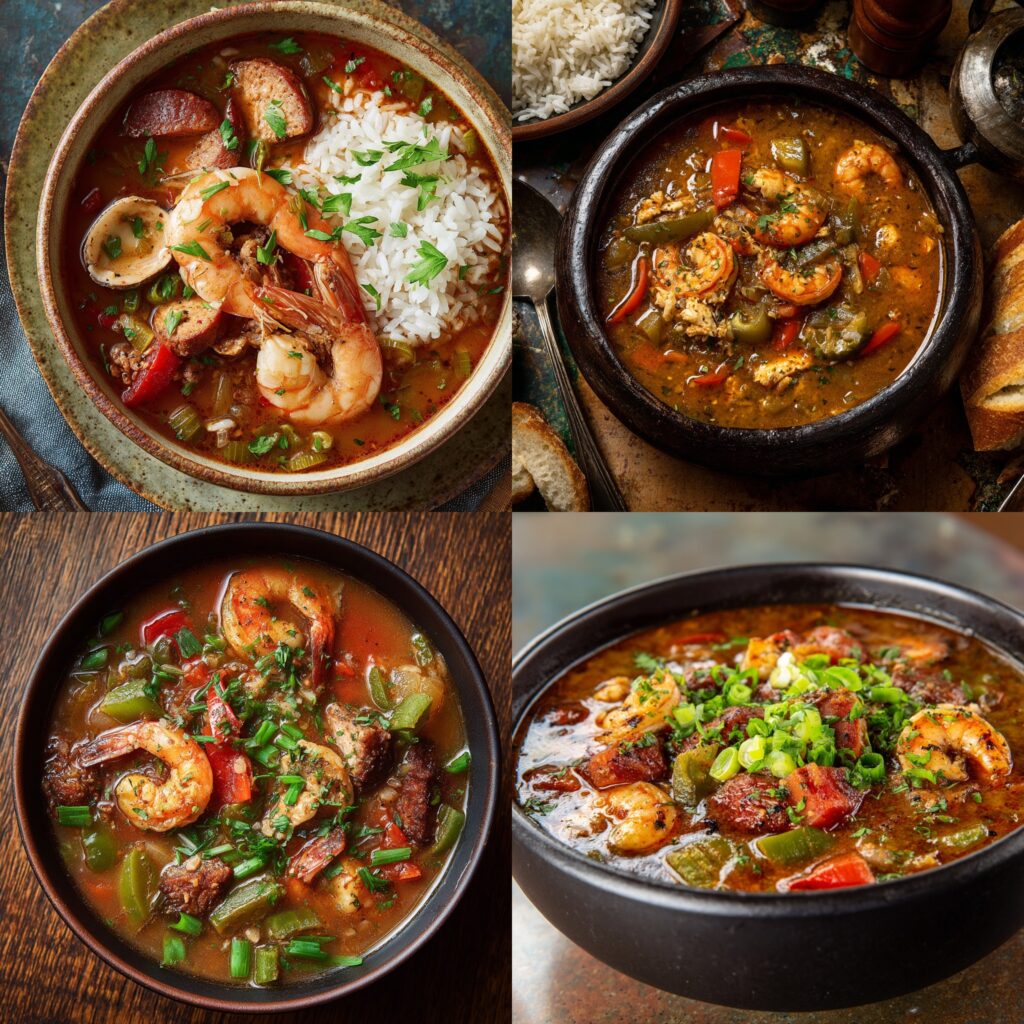A gator gumbo recipe is one of the best ways to satisfy your craving for real Louisiana comfort food. This dish is based on Cajun and Creole traditions. It combines the strong, smoky flavors of the bayou with tender alligator meat, fresh vegetables, and a thick, dark roux. Gator gumbo is a tasty adventure that you should try whether you’re making it for a weekend party or just to see how well you can cook southern food.
A gator gumbo recipe gives you a different texture and a mild, slightly gamey flavor that goes well with classic spices like paprika, cayenne, and thyme. This is different from chicken or seafood gumbo. The spicy sausage, bell peppers, and slowly cooked gator make a hearty stew that is both rustic and elegant. It tells the story of Louisiana’s swamps, traditions, and deep love for sharing good food with friends.
The best thing about a gator gumbo recipe is that you can use it in a lot of different ways. You can change the heat, add seafood for more flavor, or keep it simple and let the alligator be the main ingredient. Put it on top of fluffy white rice and sprinkle green onions on top. That’s a meal that really shows off southern cooking. It’s a pot of comfort, culture, and creativity.
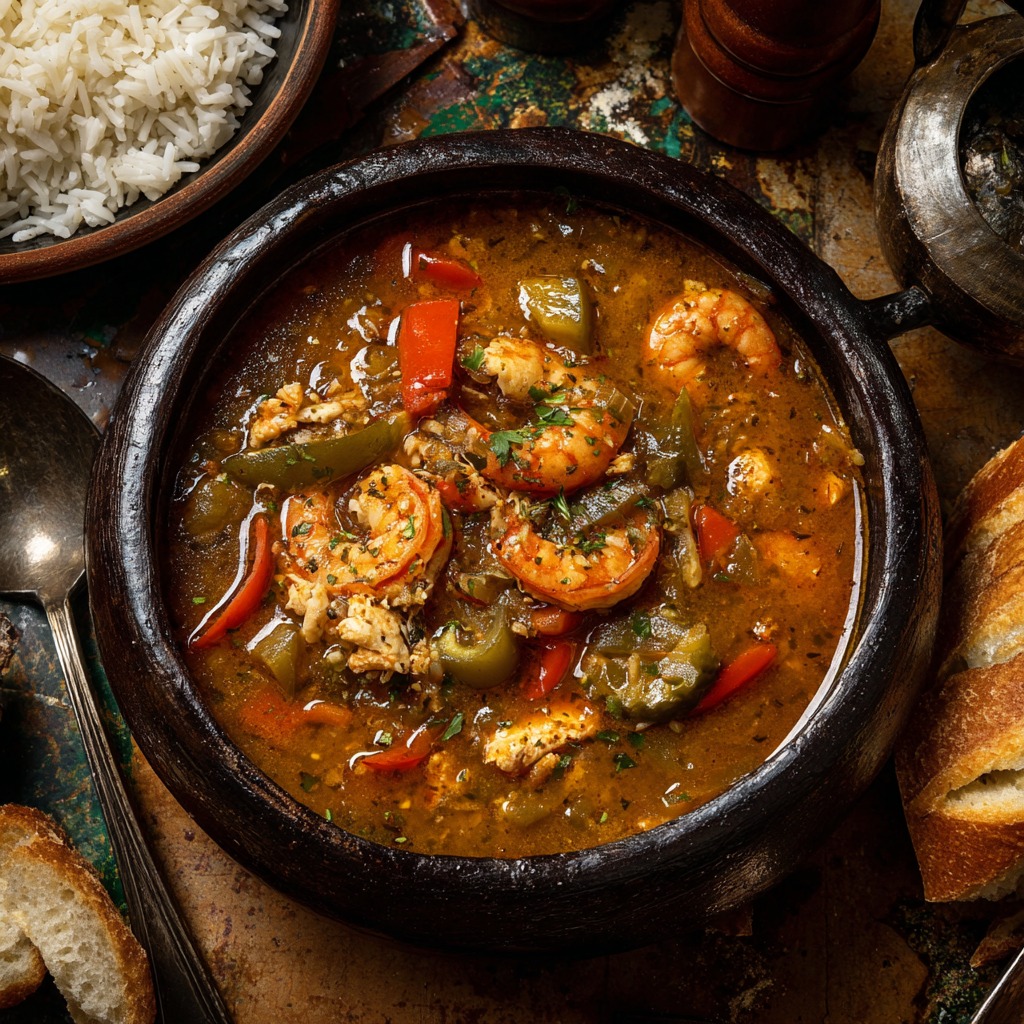
- What Is Gator Gumbo?
- Why You’ll Love This Gator Gumbo
- Ingredients You’ll Need (Serves 6–8)
- The Flavor Foundation: Making a Dark Roux (No Rush!)
- Step-by-Step: How to Cook Gator Gumbo
- Texture Talk: Roux vs. Okra vs. Filé
- Choosing & Prepping Alligator Meat
- The Seasoning Profile (Make It Yours)
- Serving Suggestions
- Make-Ahead, Storage & Reheating
- Common Mistakes (and Easy Fixes)
- Variations to Try :Gator Gumbo Recipe
- Simple Timeline (For Busy Cooks)
- Equipment Check
- Nutrition Snapshot (Approximate per Serving without rice)
- Conlusion
- Share Your Twist!
What Is Gator Gumbo?
In Louisiana, gator gumbo is a dish that replaces chicken or seafood with tender alligator. The dish has a thick, spoon-coating stew served over rice. It gets its flavor from a mahogany-colored roux, aromatics, spices, and a long, slow simmer.
Why You’ll Love This Gator Gumbo
This gator gumbo recipe has that deep, smoky-savory Louisiana flavor with soft alligator meat, the classic Cajun “holy trinity,” and a rich, mahogany roux. It’s strong enough for game day crowds but simple enough for a cozy weeknight when you want something warm, rustic, and memorable.
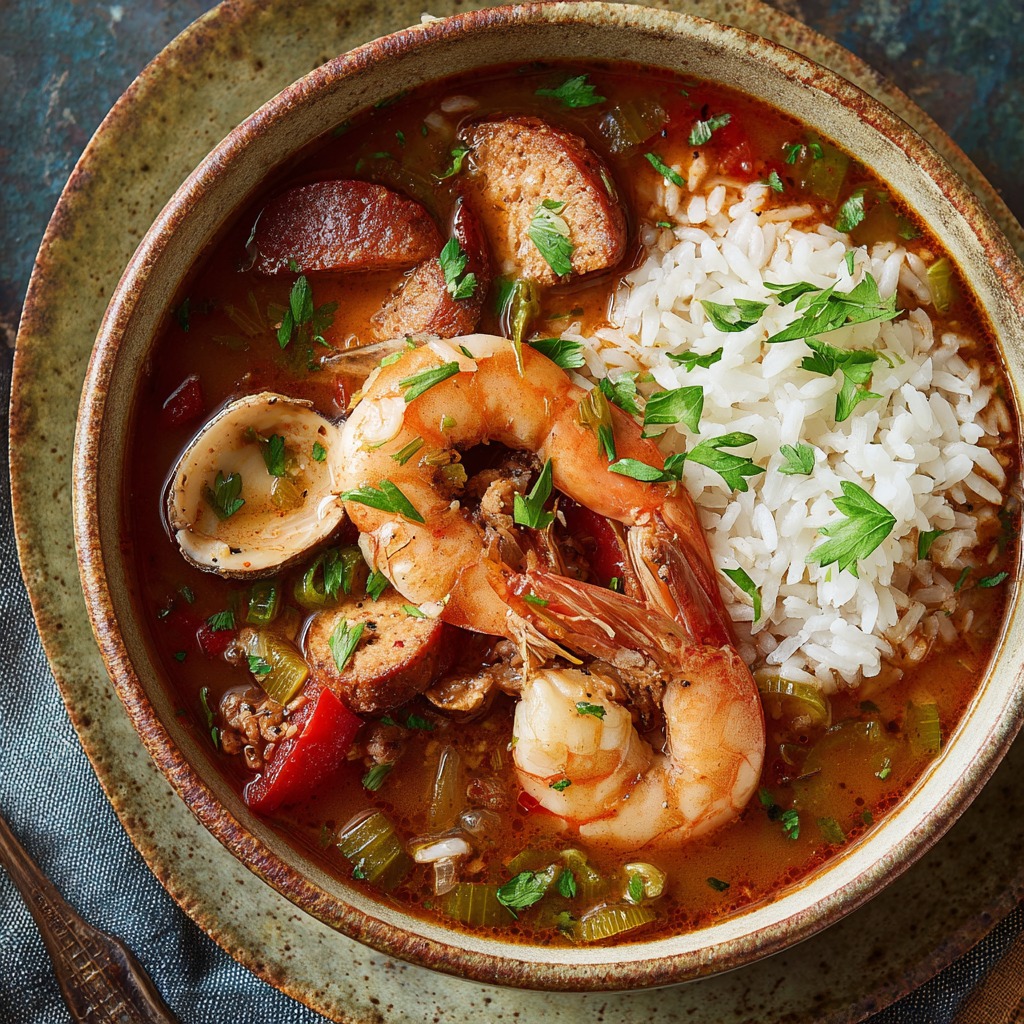
Ingredients You’ll Need (Serves 6–8)
- Alligator meat (1½–2 lb), bite-size cubes (tail or tenderloin preferred)
- Andouille sausage (12 oz), half-moons
- Neutral oil (¾ cup) — canola/peanut/vegetable
- All-purpose flour (¾ cup)
- Yellow onion (1 large), diced
- Green bell pepper (1 large), diced
- Celery (3 ribs), diced
- Garlic (4 cloves), minced
- Okra (2 cups, sliced) — fresh or frozen (optional but classic)
- Crushed tomatoes (1 cup) — optional for a Creole lean
- Seafood or chicken stock (6–7 cups), warm
- Bay leaves (2)
- Cajun seasoning (2–3 Tbsp), plus more to taste
- Smoked paprika (1 tsp)
- Dried thyme (1 tsp)
- Kosher salt & black pepper to taste
- Worcestershire (1–2 tsp)
- Hot sauce (to taste)
- Cooked white rice (for serving)
- Scallions & parsley (for garnish)
- Filé powder (optional, at the table)
Tip: If your Cajun seasoning already has salt, adjust added salt later.
The Flavor Foundation: Making a Dark Roux (No Rush!)
A roux that is cooked low and slow is the first step in making a great Gator Gumbo. In a heavy pot over medium-low heat, mix equal parts oil and flour. Stir the roux constantly, scraping the bottom and corners, until it turns from dark peanut butter to milk chocolate. This usually takes 25 to 40 minutes, depending on the heat and pan. Patience now means depth later.
Step-by-Step: How to Cook Gator Gumbo
- Brown the sausage. In a large Dutch oven, sear andouille over medium heat until browned; remove and reserve.
- Make the roux. Add oil and flour; stir constantly until deep brown.
- Sweat the trinity. Stir in onion, bell pepper, and celery; cook 5–7 minutes until softened and glossy. Add garlic; cook 30 seconds.
- Season. Sprinkle in Cajun seasoning, smoked paprika, thyme, salt, and pepper; stir to bloom spices.
- Build the body. Whisk in warm stock gradually to avoid lumps. Add bay leaves and Worcestershire. If using tomatoes, add now.
- Okra & simmer. Add okra (if using). Simmer 20–25 minutes, gentle bubbles, uncovered, stirring occasionally.
- Cook the gator. Add alligator and the browned sausage. Simmer gently 10–15 minutes until gator is tender and opaque avoid rapid boiling.
- Finish & balance. Adjust salt, pepper, and heat with hot sauce. If you like a silkier finish, stir a pinch of filé off heat right before serving (or offer at the table).
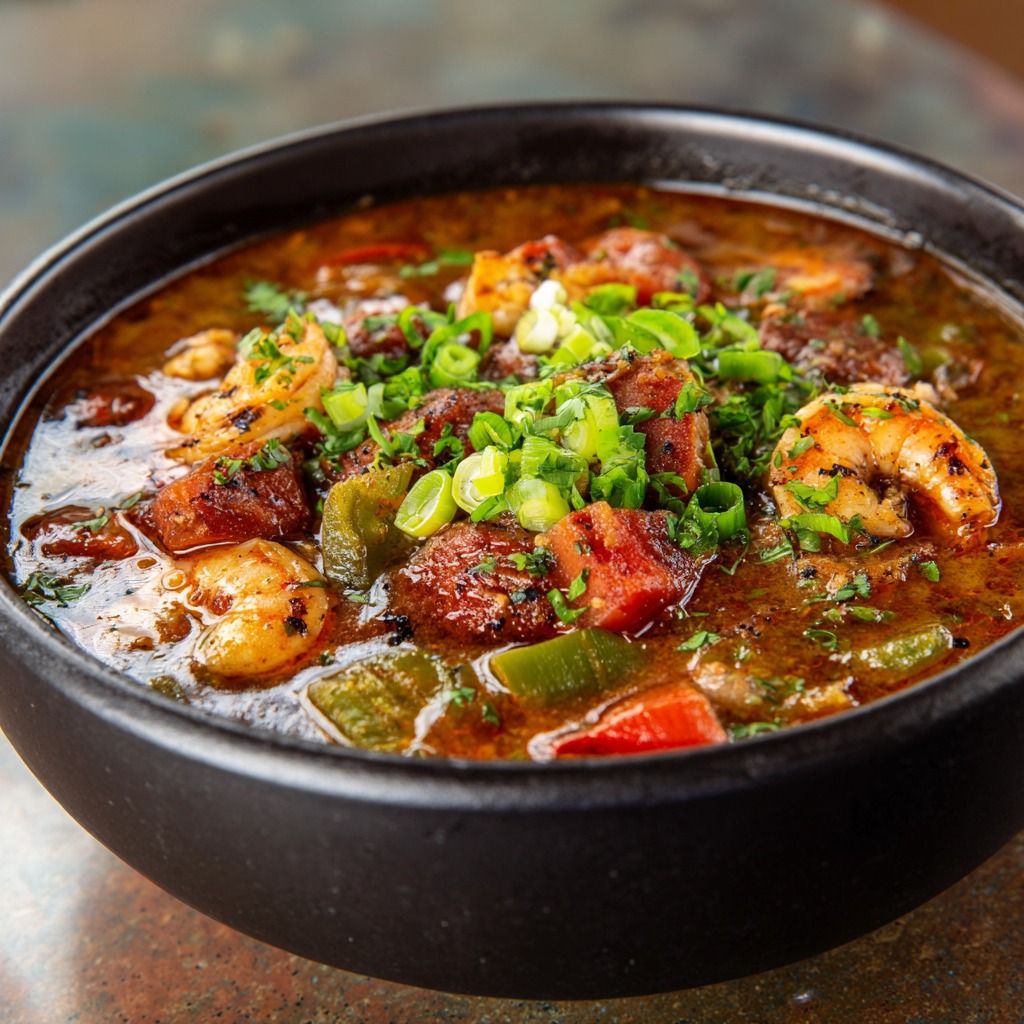
Texture Talk: Roux vs. Okra vs. Filé
- Roux gives nutty depth and body.
- Okra adds classic Southern texture and natural thickening.
- Filé powder (ground sassafras) adds sheen and a subtle, woodsy note—stir in off heat to prevent stringiness.
Use one or mix two; many cooks combine a roux with either okra or table-side filé.
Choosing & Prepping Alligator Meat
- Best cuts: tail or tenderloin for mild flavor and tenderness.
- Trim: remove any silver skin.
- Marinate (optional): 30–60 minutes in buttermilk + a pinch of Cajun seasoning can further tenderize and mellow any gamey notes; pat dry before cooking.
- Don’t overcook: gentle simmering keeps the meat succulent.
The Seasoning Profile (Make It Yours)
- Mild & cozy: start with 2 Tbsp Cajun seasoning, minimal hot sauce.
- Bold & smoky: add extra smoked paprika and a splash of liquid smoke.
- Zesty heat: cayenne or fresh minced jalapeño during the trinity step.
Serving Suggestions
Ladle Gator Gumbo over hot white rice in warmed bowls. Top with sliced scallions, chopped parsley, and a few dashes of hot sauce. Add a side of crusty bread or skillet cornbread to catch every drop.
Make-Ahead, Storage & Reheating
- Make-ahead: Like many stews, flavor deepens overnight.
- Fridge: Cool quickly; store up to 3–4 days in airtight containers.
- Freeze: Up to 2–3 months (okra can soften; still tasty).
- Reheat: Low and slow on the stovetop with a splash of stock or water. Avoid hard boiling.
Common Mistakes (and Easy Fixes)
- Roux scorches (bitter): If you see black flecks or smell acrid notes, start over.
- Gumbo too thin: Simmer longer uncovered; or whisk 1 tsp filé off heat.
- Gator tough: You likely boiled it hard or too long. Keep it at a gentle simmer and check early.
- Too salty: Add unsalted stock or a ladle of cooked rice to absorb some salinity.
Variations to Try :Gator Gumbo Recipe
- Seafood Gator Gumbo: Add shrimp in the last 3–4 minutes of simmering; swap to seafood stock.
- Smoky Turkey & Gator: Use leftover smoked turkey instead of andouille; outstanding after the holidays.
- Greens Gumbo Twist: Stir in chopped mustard or collard greens for extra body and aroma.
- One-Pot Weeknight: Use pre-made dark roux (jarred) to cut time; still big on flavor.
Simple Timeline (For Busy Cooks)
- 0:00–0:10: Brown sausage; start roux.
- 0:10–0:40: Stir, stir, stir—bring roux to dark brown.
- 0:40–0:55: Trinity + spices; whisk in warm stock; add bay, okra, tomatoes (if using).
- 0:55–1:15: Simmer base.
- 1:15–1:30: Add gator + sausage; gentle simmer. Finish and serve.
Equipment Check
A heavy Dutch oven (or other thick-bottomed pot), wooden spatula for roux, sharp knife, cutting board, whisk, and ladle. Warm serving bowls make a difference.
Nutrition Snapshot (Approximate per Serving without rice)
Gumbo is hearty and protein-forward with moderate fat from the roux and sausage. To lighten it up, reduce oil to ½ cup, use turkey andouille, and load up on okra and aromatics.
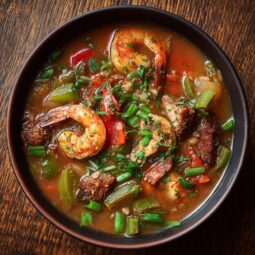
Authentic Louisiana Gator Gumbo Recipe
Equipment
- Heavy Dutch oven or large stockpot
- Wooden spoon or roux whisk
- Cutting board and sharp chef’s knife
- Measuring cups & spoons
- Heatproof ladle
- Serving bowls
- Optional: Cast-iron skillet (for browning sausage)
Ingredients
- Serves 6–8
- 1½ –2 lbs alligator meat cubed (tail or tenderloin preferred)
- 12 oz andouille sausage sliced into half-moons
- ¾ cup vegetable or canola oil
- ¾ cup all-purpose flour
- 1 large yellow onion diced
- 1 green bell pepper diced
- 3 ribs celery diced
- 4 cloves garlic minced
- 2 cups okra sliced (fresh or frozen, optional)
- 1 cup crushed tomatoes optional, for Creole-style gumbo
- 6 –7 cups chicken or seafood stock warmed
- 2 bay leaves
- 2 –3 Tbsp Cajun seasoning
- 1 tsp smoked paprika
- 1 tsp dried thyme
- Salt and black pepper to taste
- 1 –2 tsp Worcestershire sauce
- Hot sauce to taste
- Cooked white rice for serving
- Scallions and parsley chopped (for garnish)
- Filé powder optional, to finish
Instructions
- Brown the sausage: In a large Dutch oven, cook andouille slices over medium heat until browned. Remove and set aside.
- Make the roux: In the same pot, add oil and flour. Stir constantly with a wooden spoon over medium-low heat until the roux turns dark brown about 25–40 minutes. Do not let it burn.
- Add the vegetables: Stir in onion, bell pepper, and celery. Cook for 5–7 minutes until softened. Add garlic and cook 30 seconds more.
- Season the base: Stir in Cajun seasoning, smoked paprika, thyme, salt, and pepper. Let the spices bloom for 30 seconds.
- Build the gumbo: Gradually whisk in the warm stock, a little at a time, to avoid lumps. Add bay leaves, Worcestershire sauce, and crushed tomatoes if using.
- Simmer and thicken: Add okra (optional). Simmer uncovered for about 20–25 minutes, stirring occasionally.
- Add the gator and sausage: Return the browned sausage to the pot and add the alligator meat. Simmer gently for 10–15 minutes, or until the gator is opaque and tender. Avoid boiling.
- Finish and taste: Adjust seasoning with salt, pepper, and hot sauce. If desired, stir in a pinch of filé powder off the heat for extra richness.
- Serve: Spoon the gumbo over cooked white rice. Garnish with chopped scallions and parsley. Serve hot with cornbread or crusty bread.
Notes
- Alligator meat tips: The tail or tenderloin cuts are best for tenderness. You can marinate in buttermilk for 30 minutes to reduce gaminess.
- Roux care: If it smells burnt or turns black, start over—burnt roux ruins gumbo flavor.
- Make-ahead: Gumbo tastes even better the next day after the flavors meld.
- Storage: Keep leftovers refrigerated for up to 4 days or frozen for up to 3 months.
- Substitutions: Chicken, shrimp, or crawfish can replace alligator if unavailable.
- Heat level: Adjust Cajun seasoning and hot sauce to preference.

Conlusion
This Gator Gumbo Recipe will make you feel at home in Louisiana with its deep, mahogany roux, tender alligator, and the classic Cajun trinity. Browning the sausage, stirring the roux slowly, and simmering the stock all add layers of smoky, savory flavor that are both rustic and special. It’s a bowl that makes you feel better and impresses your guests, whether it’s game day or a quiet weeknight.
Add okra or filé to make it your own, adjust the heat to your liking, and serve it over fluffy rice with fresh scallions and parsley. Don’t be afraid to make a big pot of leftovers; they taste even better the next day. If you have the right ingredients and are patient, this gumbo will give you that soulful Southern taste in every bite.
Share Your Twist!
You can now make this Gator Gumbo Recipe your own. Every Louisiana kitchen puts its own spin on things. For example, they might add a splash of beer to the roux, make their own smoky seasoning, or add some shrimp for extra flavor. Gumbo is all about family, flavor, and creativity, no matter if you like it spicy, mild, or extra thick.
Did you try this version or make some changes? Tell your friends or leave a comment with your twist. Your story might give someone else the idea for their next perfect pot of gumbo!

